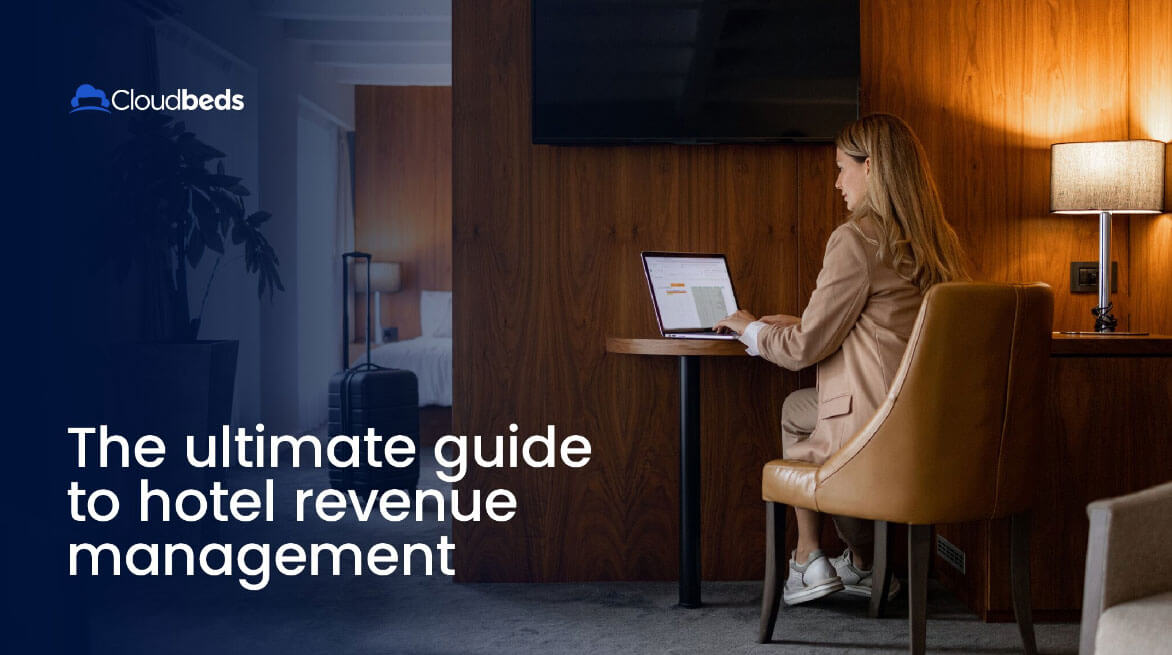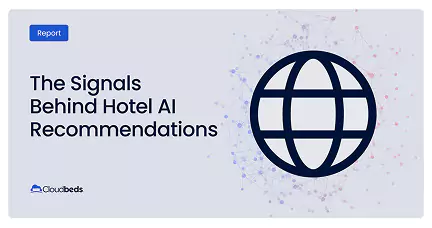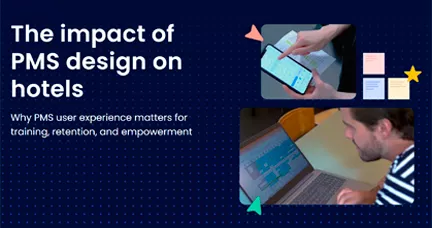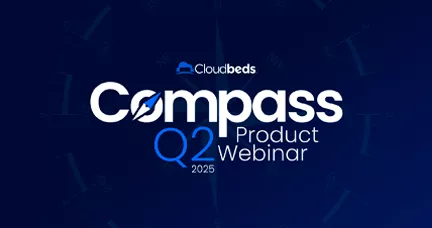
For years, revenue management meant spreadsheets, historical reports, and a constant race to keep up with your compset. It was reactive, siloed, and often reserved for big brands with big budgets.
But hospitality has changed. Traveler behavior has shifted. Booking patterns are less predictable. Margins are tighter. And decisions can’t wait.
Today’s revenue leaders need more than just data; they need clarity, speed, and confidence.
That’s where the new era of revenue management comes in. Powered by AI, automation, and real-time insights, modern hotel revenue strategies go beyond forecasting and rate setting. They connect the dots between revenue and marketing, operations and guest behavior, demand signals and pricing decisions.
Here we explore how hotels can take advantage of this shift, with guidance, tactics, and technology to drive revenue growth.
What is revenue management?
Revenue management is the art and science of selling the right room, to the right guest, at the right price, at the right time. It’s about using data to make smarter decisions, not just relying on instincts or outdated rules of thumb. That includes looking at your hotel’s performance, local market demand, competitor pricing, and trends to optimize rates and availability across your channels.
Modern revenue strategies use forward-looking data and predictive analytics to uncover what’s really happening in your market, helping you forecast demand more accurately, price more competitively, and respond faster to shifts in booking behavior. The smartest operators are aligning revenue and marketing, using shared insights to target the right guests with the right message and the right price.
What revenue management is not
Revenue management in the hotel industry isn’t just about copying your comp set’s pricing, chasing after 100% occupancy, or saying yes to every group inquiry that hits your inbox. In fact, doing those things without a strategy can do more harm to your financial performance than good.
Yes, keeping an eye on competitors and managing occupancy are important, but they’re just one piece of the puzzle. If you don’t factor in your own property’s unique data and market dynamics, you’re flying blind.
To build a winning strategy, you need to consider:
- Your property’s specifics (location, brand, target guest)
- Real-time market conditions
- Booking patterns like pace, length of stay, and lead time
- Future demand indicators (not just what’s on the books now)
- Guest price sensitivity and ideal customer profiles
- Market trends and seasonality
- Historical data (your own, not just the competitive set)
Another common myth? Treating revenue and marketing like separate silos. Today, your pricing decisions should be deeply connected to your demand generation efforts. With AI-powered tools, hotels can now sync revenue and marketing strategies, pulling from the same source of truth to drive smarter promotions, optimize campaigns, and fill the right hotel rooms with the right guests.
Yield management vs. revenue management
These terms are often used interchangeably, but they’re not the same, and if you want to build a more profitable hotel business, it’s worth knowing the distinction.
Yield management is about maximizing revenue from a fixed, perishable asset—like a room night—at a specific moment in time. It’s the classic “right room, right guest, right price, right time” strategy, often focused on optimal pricing for peak periods or optimizing occupancy.
Revenue management, on the other hand, takes a step back and looks at the bigger picture. It’s a comprehensive, data-driven approach to growing your total revenue, not just from rooms, but across all departments and segments. It includes forecasting, segmentation, distribution, and pricing strategy, often months (or even a year) in advance.
Here’s one way to look at it:
- Yield management is trying to sell tonight’s room at the best possible rate
- Revenue management is figuring out how to fill your hotel next month with the most profitable mix of guests across the best-performing channels
Act with clarity, speed, and confidence.
See how to develop a comprehensive revenue management strategy.
Key indexes in revenue management
Here are the foundational key performance indicators (KPIs) every hotel should know, and how they apply to revenue performance.
Occupancy & average daily rate (ADR)
These two metrics are often viewed as the go-to indicators of hotel performance. But taken alone, they don’t tell the whole story. High occupancy rate with low ADR? You’re filling rooms, but not maximizing revenue. High ADR with low occupancy? You might be overpriced for the market.
Revenue per available room (RevPAR)
RevPAR is a step up. It blends occupancy and ADR to give you a clearer snapshot of how well you’re converting available room nights into revenue. It’s especially useful for benchmarking your performance against competitors in your comp set.
Total revenue per available room (TRevPAR)
Guests aren’t just booking beds, they’re investing in an experience. TRevPAR accounts for all revenue streams, from rooms to cocktails and parking passes. It helps you understand the true revenue value of every guest.
Gross operating profit per available room (GOPPAR)
GOPPAR subtracts operating costs from total revenue, giving you a clearer picture of what each room actually earns. It’s a key step toward sustainable growth.
Total profitability
Total profitability zooms out even further, combining performance, cost efficiency, and demand generation to show how effective your commercial strategy really is. This is where revenue marketing comes in, breaking down the walls between revenue and marketing teams to maximize revenue potential across the entire guest journey.
Hotel revenue management strategies
Cloudbeds’ 2025 State of Independent Lodging Report found that after years of steady growth, global ADR declined by 1% in 2024, a small drop, but a big signal. Demand is softening, and guests are becoming more price-sensitive. And for hoteliers already dealing with rising costs and labor shortages, that margin pressure hits hard.
The hotels that will come out ahead are the ones that stop reacting and start proactively using data analysis to drive strategy.
That’s where smarter revenue management makes all the difference, leveraging technology to align pricing, marketing, and distribution around shared profitability goals.
Here, we explore some effective revenue management strategies.
Small drops, big signals.
Discover the trends impacting hotels in 2025.
1. Create a well-balanced distribution strategy
Let’s get one thing straight: distribution isn’t just about visibility, it’s about control. You need the right mix of distribution channels to attract high-quality demand and protect your margins.
The smartest hotels don’t just optimize inventory; they connect the dots between pricing, availability, and promotional strategy. That means aligning with your marketing and sales teams to ensure the timing of campaigns matches rate plans, that direct channels are getting enough love, and that you’re not overexposing your rooms on third-party sites.
A revenue-optimized channel management strategy should include:
- Your direct website, powered by an integrated booking engine
- A mix of global, regional, and niche online travel agencies (OTAs)
- Metasearch engines
- Organic social media and paid ads
- Bed banks
- The GDS
Distribution should evolve and change based on demand signals. That means monitoring booking pace, lead time, pickup by booking channel, cancellation rates, and overbookings, and even campaign performance data to decide where to lean in or pull back.
For example, if summer weekends are pacing slower than expected, but your direct website is converting well, don’t panic and slash rates across OTAs. Instead, ramp up your direct booking efforts by running a metasearch campaign, launching a limited-time offer, and keeping OTA inventory focused on last-minute or midweek gaps where it performs best.
2. Collect and respond to online reviews
Online reviews have always played an important role in a hotel’s success, but today, they go beyond guest perception. They directly impact your ability to increase overall revenue.
This is where the concept of reputation pricing comes in. Properties with higher review scores often command higher rates. That’s because guests are willing to pay more when they see consistent, positive feedback and timely, thoughtful responses. In other words, improving your reputation doesn’t just enhance guest satisfaction, it increases pricing power.
It’s important to monitor reviews across platforms like Tripadvisor, Google, OTAs, and social media, and to respond with care. But just as important is using the feedback to improve operations. Patterns in guest reviews can reveal experience gaps that, once addressed, lead to better reviews and stronger performance.
This was also one of the key takeaways from Cloudbeds’ AI Recommendations Report, which analyzed the factors influencing hotel visibility in AI-powered travel search. High-ranking properties consistently had strong, recent review activity and demonstrated a commitment to guest-centric improvements.
Better guest experiences lead to better reviews. And better reviews give you room to grow your rates with confidence.
Want to know how to appear in AI search?
Discover the signals AI considers when recommending hotels.
3. Implement a thoughtful upselling strategy
Upselling is often one of the most underutilized strategies in hospitality. It can feel like a lot of extra work—another task to fit into an already packed day, especially when teams are stretched thin.
But the reality is, upselling doesn’t have to be complicated. When it’s built into your existing tools and guest journey, it becomes a low-effort, high-impact way to drive more revenue and enhance the guest experience at the same time.
Modern upselling isn’t just about offering a room upgrade at check-in. Today, there are multiple ways to build upsell opportunities into your workflow, including:
- At the time of booking, through your booking engine
- Via personalized pre-arrival messages, using customer segments in your CRM
- In-stay communications, using guest messaging tools
- Through your front desk staff, when they’re trained to recognize opportunities and offer relevant suggestions
The key is personalization. A late checkout offer may appeal to a leisure traveler but not a business guest. A local tour might resonate with a first-time visitor but feel irrelevant to a returning guest. That’s why segmentation matters and why integrating your upselling strategy with your CRM and PMS can make a big difference.
4. Manage room type differentials
As part of inventory management, many hotels set their room type pricing and forget it, but adjusting your room type differentials (the price gaps between categories) is one of the most overlooked levers in revenue optimization.
The value of a room type changes based on who is booking and when. For example, your two-bedroom suites may see high demand in the summer when families are traveling, while standard rooms may be more popular midweek in the winter with business travelers. If the price difference between those room types stays the same year-round, you’re likely leaving money on the table.
That’s why it’s important to:
- Monitor booking patterns by room type throughout the year
- Analyze pace and pickup by segment and season
- Adjust price gaps dynamically, based on demand and perceived value
This doesn’t mean changing rates constantly, but it does mean being thoughtful about how you position your room inventory, especially during high-demand periods. A small increase in suite pricing when demand is strong can result in a meaningful lift in TRevPAR, without changing base rates across the board.
5. Maximize ancillary revenue
Room revenue may be your primary focus, but it’s rarely your only revenue stream. Food and beverage, parking, spa services, events, retail, and even commissions from tours or experiences can all contribute meaningfully to your bottom line.
The key is to stop treating these as isolated departments and start thinking in terms of total hotel profitability. Sometimes, the best way to grow revenue is by adjusting one area to lift another.
For example:
- Offer a restaurant discount to secure a high-value group booking
- Provide discounted room rates to casino guests who are likely to spend more on-site
- Bundle breakfast or spa access into a package that increases perceived value and booking conversion
The goal isn’t to squeeze more out of every guest but to design offers and pricing strategies that optimize the total revenue each guest brings in, across their full experience.
And with the right data (from your PMS, POS, and CRM), you can identify patterns in guest behavior and tailor offers accordingly.
6. Segment your audience
An often overlooked aspect of revenue management is the importance of segmentation, the practice of grouping hotel guests into categories based on shared consumer behaviors and characteristics. When starting to segment your guests, look at:
- Booking behavior (channel, lead time, length of stay, cancellation rate)
- Purpose of travel (leisure, corporate, group, extended stay)
- Lifestyle or preferences (budget-conscious, luxury, experience-seeking)
- Room type preferences and spend patterns
Once you’ve identified meaningful market segments, you can begin to optimize your strategy. For example, if families are one of your top segments, you might increase suite pricing during school holidays or offer bundled perks during spring break. During slower periods, shift focus to corporate travelers with flexible midweek rates and added-value offers.
Segmentation also plays a major role in aligning revenue and marketing. A well-segmented CRM lets you send more relevant pre-arrival emails, surface personalized upsells, and run smarter campaigns, all of which contribute to stronger conversion and increased revenue.
7. Forecast demand with greater accuracy
Forecasting has always been part of revenue management, but today, it’s about more than pacing reports and historical data.
Modern forecasting blends historical trends with real-time signals—things like website activity, search demand, local events, and competitor rate changes. With the help of AI-powered tools, hoteliers can build forward-looking forecasts that give them the confidence to act proactively, not reactively.
That means:
- Adjusting rates in advance of demand surges (dynamic pricing)
- Managing inventory more effectively across channels
- Making better staffing and operational decisions based on expected occupancy
- Planning promotional campaigns in coordination with revenue goals
Have 95% confidence in every decision
With Cloudbeds Revenue Intelligence, the only causal AI built for hotels.
8. Approach group and corporate business strategically
Not all demand is created equal. Group and corporate bookings can bring volume, but they can also displace higher-value business if not evaluated carefully.
That’s why it’s critical to treat these segments as strategic levers in your revenue plan, not just take them as they come. Start by looking at the total value of each booking, not just the room rate. Factor in things like length of stay, food and beverage spend, meeting space usage, and how far in advance the block is requested.
When evaluating group business, ask:
- Will this block displace higher-rated transient demand?
- Can I upsell ancillary services to increase total value?
- Is this the right segment for this time period?
The same goes for corporate business. Consider negotiated rates, booking patterns, and how consistent that business is year-round. Tools that integrate group booking data with forecasting can help you assess whether accepting a request is the right move or if it’s better to hold out for more profitable demand.
9. Optimize your tech stack
None of the tactics above can reach their full potential without the right technology and, more importantly, without that technology working together. A fragmented system creates silos, slows decision-making, and leaves valuable data untapped.
That’s why hotels are shifting toward integrated hospitality platforms or systems where the property management system, booking engine, CRM, revenue management system (RMS), marketing platforms, business intelligence tools, and guest engagement solutions all speak the same language. When these systems are connected, you unlock a powerful new capability: real-time, data-informed decision-making.
But the real evolution is happening with intelligence.
Solutions like Cloudbeds Revenue Intelligence bring it all together, combining guest behavior, pricing data, channel performance, marketing engagement, and demand forecasts into a unified layer of insight. These AI-powered systems don’t just collect data; they help you understand what’s happening, what’s likely to happen next, and what actions you should take to drive better results.
Building a more connected strategy
Successful revenue management in the hospitality industry is no longer just about filling rooms, but building a smarter, more connected strategy that aligns every part of your business, from pricing and distribution to marketing and guest experience.
With the right revenue management software in place and the right data, you can make better decisions faster. You can anticipate demand, respond to market shifts, and grow profitability without increasing your workload. You can stop relying on fragmented reports and outdated instincts and start acting on real-time insights that drive real results.
Move faster than ever before.
Real-time intelligence is just a click away.



